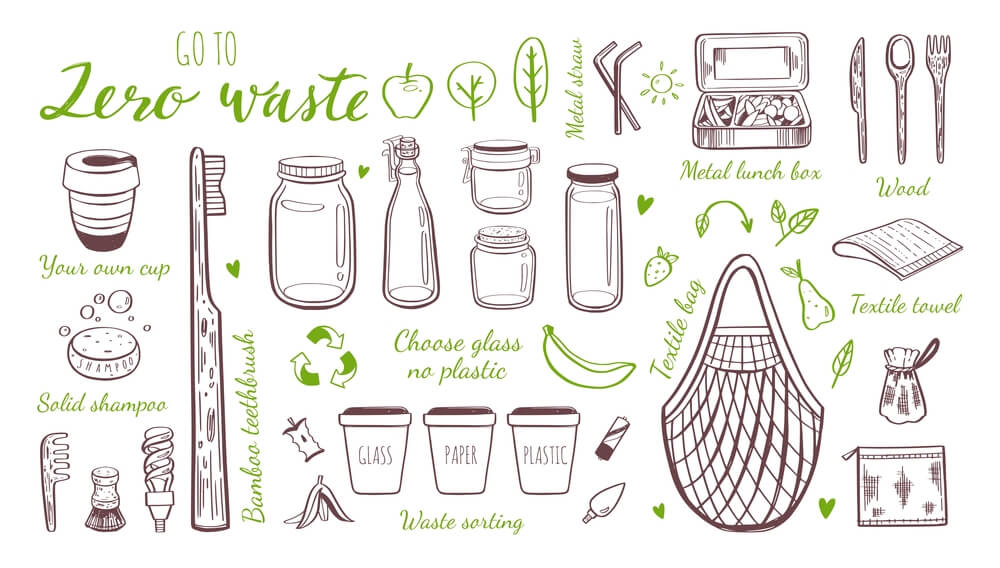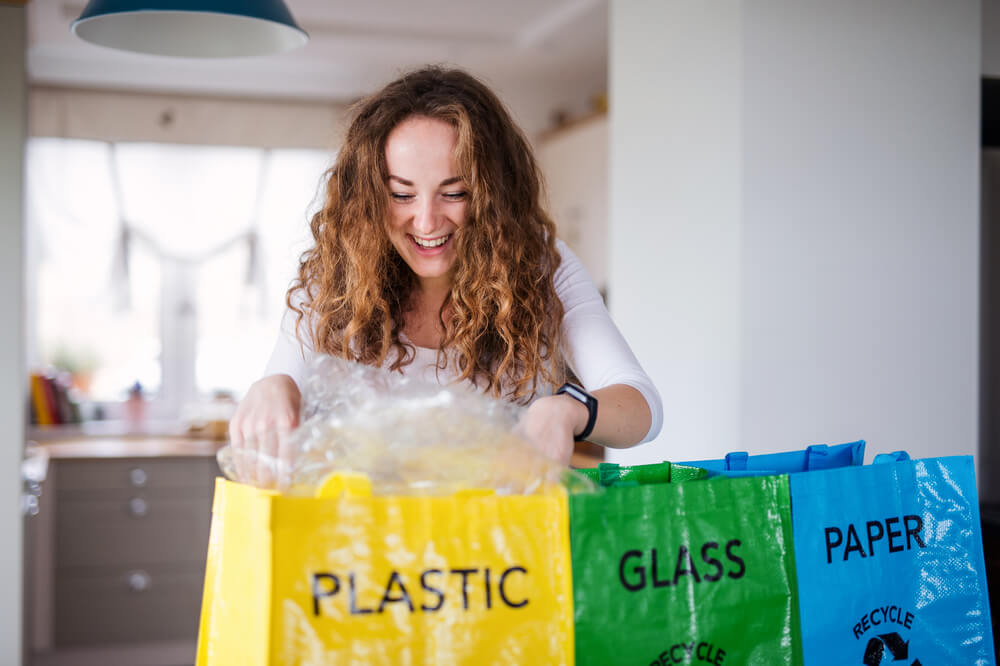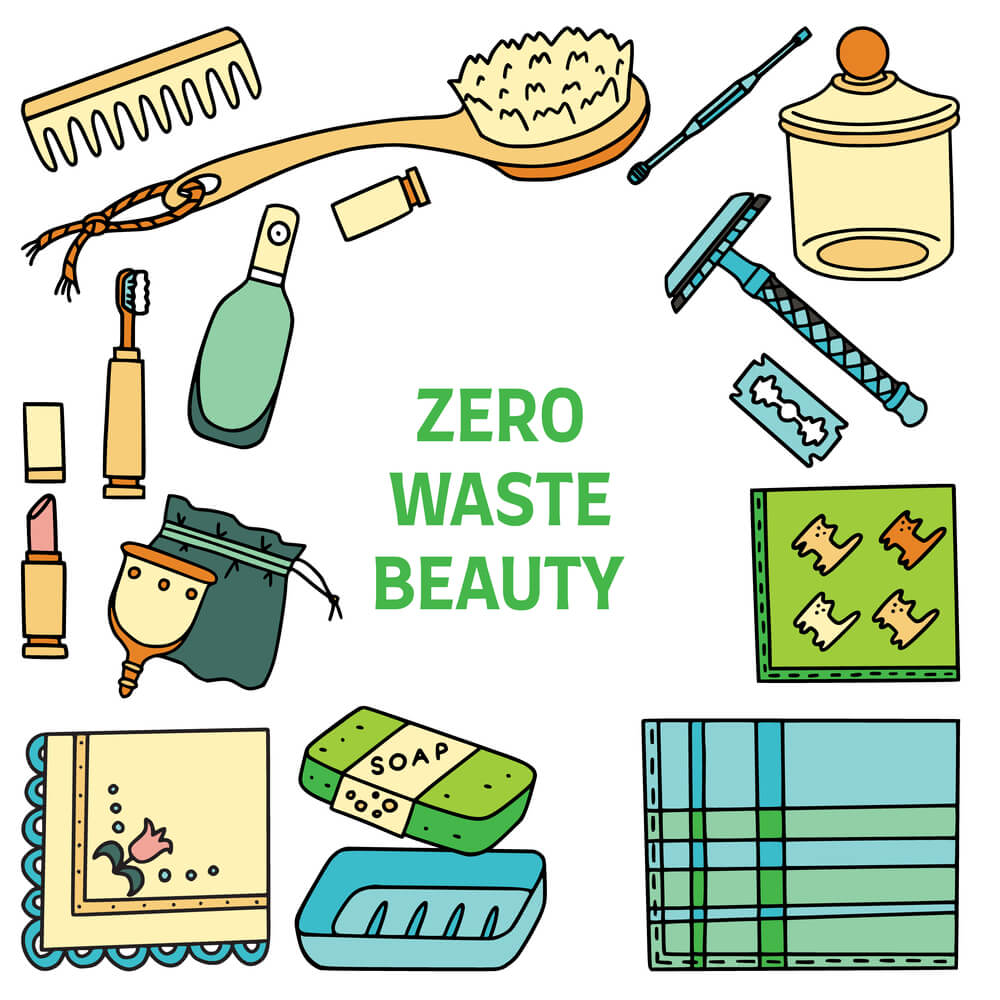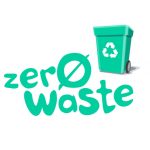“Trash is an unavoidable fact of life,” we’re told. But is it? Currently, the average American produces around five pounds of solid waste per day! That’s an alarming statistic, especially when part of that waste isn’t biodegradable.
Can we fix this sorry state of decay? Yes, we can – by creating a Zero-Waste Lifestyle.
Zero-Waste Living is a lifestyle program aimed at reducing household waste to help limit personal environmental impact.
Zero-Waste Living promotes the remediation of wasteful consumer habits and includes the recycling, reusing, and repurposing of household products and packaging.
Correcting a universal problem like environmental pollution is daunting, which is why most people don’t even try to live a low-impact lifestyle.
Every person on the planet must be aware of their role in environmental sustainability.
A Zero-Waste Program is the best place to start making a positive difference.
How to Create Your Zero-Waste Program
A Zero-Waste Program is a strategy that acts as your eco-compass, guiding you with mindfulness through the wasteland of negligent consumer behaviors towards a greener future, living in harmony with Mother Nature.
A Zero-Waste Program is all about making radical changes to the following:
- Mindset – Educating yourself and others on Zero-Waste benefits.
- Methods – Adjusting the way you shop and consume.
- Means – Changing how you process your ‘waste’.
- Money – Making Zero-Waste financially viable.
Let’s unpack each of these four strategic points of your Zero-Waste Program and discover 30 Easy-to-Implement Tips to get you on your way to Eco-Wise Living.
How To Create A Zero-Waste Mindset
The fact that you’re reading this post means you care about your environment.
You don’t suffer that primary obstacle to sustainability, that sad human predisposition called ‘apathy’!
Start your Zero-Waste journey here:
- Research online all you can about the dangers of non-biodegradable products such as plastics. Make a list of as many non-eco-friendly household products and packaging as possible.
- Compare that list to what’s normally on your shopping list. Make a firm decision to STOP BUYING THOSE PRODUCTS and replace them with eco-friendly products and packaging.
- Visit a landfill to see first-hand the magnitude of the solid waste problem. Film it on your phone or Handycam and show it to your family and friends.
- Start a social media group where you can share your Zero-Waste philosophy and provide your community with eco-wise tips.
- Be courageous in your advocacy. You will get labeled ‘self-righteous,’ etc. – ignore the naysayers and continue to educate.

How to Create a Zero-Waste Method
Changing old spending habits and lifestyle behaviors is never easy.
Still, you can reinforce your Zero-Waste Program by implementing a routine method that targets all wasteful spending and living habits.
Remember the Zero-Waste code: Refuse | Reduce | Reuse | Recycle | Rot
Focus on your household budget to isolate key waste-producing areas. Here are a few ways you can move them towards Zero-Waste:
- Groceries: Avoid plastic packaging wherever possible. Use reusable shopping bags (make them from old sheets). Shop at food markets and delis where you can buy unpackaged produce. Don’t buy single-use items (canned foods, candy bars, paper toweling).
Buy in bulk to limit packaging and transport. Glass jars containing food products make excellent reusable containers for dry foods storage, preserving cooked foods, and other household consumables.
- Household Cleaning Products: Buy detergents in bulk using bottles you bring to the store (find detergent wholesalers in your area). Make your household cleaners using vinegar and bicarbonate of soda. Use biodegradable brushes and scourers.
- Clothing: Repair old clothing. Resole your shoes. Darn socks. Patch old jeans and jackets. Convert old tee shirts into cleaning towels and cloths. Buy and sell used clothing at thrift and charity stores.
- Toiletries: Buy biodegradable, unbleached toilet paper. Use bar soaps to replace liquid soaps and shampoos sold in plastic bottles. Shave using bar soap instead of shaving cream sold in a pressurized can.
- Buy a straight razor and shun the disposables.
- Make an organic deodorant using mint and baking soda.
- Use the same recipe to make toothpaste.
- Entertainment: When eating out, take your own reusable ‘doggie bag’ for leftovers. If you’re eating takeaways, avoid Styrofoam containers and plastic utensils by bringing reusable variants.
Drink takeaway coffee in paper cups rather than plastic. Don’t use a straw for cool drinks and shakes.
- Gifts: Second-hand books, furniture, and toys make worthy gifts. Look for them online. Visit your local pawnshop for a used set of golf clubs, an angle grinder, or a gardening toolset.
- Appliances & Furniture: Always try to repair appliances that are faulty before replacing them. Reupholster old furniture. Replace plastic garden furniture (when it expires) with rattan, wood, or bamboo designs. Convert old wooden pallets into funky tables and benches.
- Utilities: Minimizing your impact on the environment means lowering your carbon footprint. Reduce energy consumption and water usage. Switch off lights when they’re not needed. Insulate your home with eco-friendly materials. Harvest rainwater from your roof and store it in a large tank.
If you’ve been considering solar power, install a solar geyser to cut your electricity bill and carbon footprint. Consider a small solar power setup to run other appliances in and around your home.
- Transport: Optimize your routine trips by car. Careful logistics planning to combine shopping, school runs, and general household maintenance travel will lower your fuel consumption and your car’s carbon footprint.
Clocking lower mileage will also reduce parts replacement on your vehicle (think tires, batteries, oil filters, brake pads, spark plugs), and you’ll save a ton of money.
Start walking more to visit friends or go shopping. Ride a bicycle or take a bus. Carpool with colleagues to get to work.
- Garden: Compost all your vegetable scraps. Don’t put dry leaves and mowed grass into bin liners for the garbage truck to remove – use them as mulch and steer clear of bin liners.
You can eliminate chlorine and acid if you have a pool by turning your pool into a pond with water plants and fish. You won’t have to backwash it as much either, and you can still swim in it if your choice of fish isn’t piranha!

How to Create the Means to Zero-Waste
Every Zero-Waste household needs a waste-processing infrastructure – a set of eco-friendly mechanisms that work together to give you the necessary means to steadily reduce your waste generation.
The ‘means’ to achieving lower waste output include various ‘waste stations’ in and around the house that allow you to separate various products for reuse, recycling, and repurposing. Structures built to optimize natural resources form part of the household Zero-Waste infrastructure.
These waste stations and structures include:
- Separate bins – for organic waste, plastics, paper, metals, and glass.
- Storage shed – for products to be repurposed, upcycled or used as construction material for home DIY projects.
- Composting bins – transform waste organic matter like vegetable peels, tea leaves, coffee grounds, and eggshells into nutrient-rich compost for your garden.
- Vegetable, herb, and fruit garden – because home-grown produce will reduce your reliance on commercial products and drastically reduce your waste burden (don’t forget the cost and health benefits).
- Water storage tanks – connected to the house plumbing and guttering systems to recycle greywater from household activities (laundry, showering, washing dishes) and harvest rainwater for garden irrigation purposes.
- Solar power system – reduce your reliance on the municipal power grid and lower your carbon footprint. You will also become far more conservative in your use of electrical appliances, which will prolong their service life.
- Septic tank – to take control of your human waste processing. The processed water from the tank makes an excellent fertilizer for the garden.
How to Save and Make Money from Zero-Waste Living
By implementing a Zero-Waste Program using these methods and means, you’ll definitely save money.
You may achieve a level of expertise to consider turning your Zero-Waste Living adventure into a profitable enterprise.
Zero-Waste Living is a skill that has a commercial value for people wanting to reduce their environmental impact through eco-wise living.
People with Zero-Waste experience can offer consultancy services and waste recycling and repurposing services in exchange for money.
There’s no better demonstration of knowledge than having a working model of your expertise. In a Zero-Waste Living context, this would be your home.
Let’s draft a plan of what the perfect Zero-Waste home could look like and then focus on moneymaking opportunities using your home as the foundation for a Zero-Waste business.

What the Ideal Zero-Waste Home Should Have
- Solar System: The amount of power you will need for your Zero-Waste household needs to be quantified before investing in solar panels, batteries, and an inverter.
Use an online calculator to get a clear picture of what your solar system needs to achieve and how much it’ll cost to install:
Visit – https://sunwatts.com/solar-calculator/
- Biogas Composting System: If you want to take your compost bins to the next, you could invest in a biogas digester that converts vegetable waste into combustible biogas, used to cook food and heat your home.
A home biogas digester can also function as a composting toilet to produce biogas in an integrated system combining vegetable biomass.
These biogas digesters are an entirely closed system, so they’re safe, healthy, and energy-efficient. Besides the valuable biogas they generate, they also produce nutrient-rich fertilizer for your vegetable garden and flowerbeds.
Visit – www.homebiogas.com
- Water Harvesting System: Most people are aware of the need to conserve water. Any Zero-Waste home will have some form of water conservation methodology in place, even if it’s simply taking short showers instead of bathing.
Installing a rainwater harvesting system in your Zero-Waste home will give you water security – an asset not to be underestimated. Going without water for simply a few hours is far worse than having no electricity.
For more info on rainwater harvesting systems, visit – www.rainwaterharvesting.org/urban/components.htm
- Energy Efficient Vegetable Garden: You don’t necessarily need to build a greenhouse or install an expensive hydroponics system with electric pumps and miles of plastic piping.
You can create a productive fresh produce garden using simple methods and repurposed waste products like large plastic totes, plastic pop bottles, and pallet wood.
Watch this video to see how sustainability and self-sufficiency can work in an urban setting: https://youtu.be/WeNaMlibiak
See how to create a thriving urban produce farm here:
- Zero-Waste Kitchen
The Zero-Waste journey invariably starts in the kitchen. It’s mostly about reducing your reliance on convenience food products. You can start by writing a Zero-Waste menu plan.
Cook fresh food in bulk and freeze it in repurposed plastic containers, reusable zip-lock bags, and glass jars and bottles. Doing this will lower your energy consumption and reduce your volume of non-recyclable waste.
Use chest freezers to lower energy consumption. Because of their superior insulation properties, chest freezers draw less electricity than regular fridges. You can convert a chest freezer into a fridge simply by installing a special thermostat to regulate the refrigerator’s temperature.
Watch this video to see how: https://youtu.be/P7wQ8Vk43vc
- Repurposing Workshop
You’re going to need extra space to store your ‘waste’ products until they are assigned a new life purpose. Use pallet wood to build the shed. You can buy used pallets for next to nothing. Some businesses like hardware stores and wholesalers give them away.
Go to YouTube to see how to make a storage shed using pallets. There’s no shortage of these useful instructional videos, and here’s an example to get you started: https://youtu.be/ckVhLiJO4Ec
- Zero-Waste Advocacy Office
You will need an admin office where your Zero-Waste Living story comes together.
If you’ve got a head for accounting, you will be keeping a balance sheet on your monthly household expenses.
Comparing your old household expenses against your new Zero-Waste Living expenses will give you tangible proof of your success or failure in the endeavor.
A Zero-Waste Program applied with commitment and diligence will produce positive financial benefits, albeit perhaps only manifesting after several months of cutting back on your household waste output.
You can document these Zero-Waste Living financial figures, along with videos, photographs, and social media articles and blogs.
These media assets can act as marketing tools for your Zero-Waste Living consultancy.
Create a website, Facebook page, YouTube channel, and WhatsApp groups to build your Zero-Waste community.
Remember – Zero-Waste is a collective effort, but every community needs a torchbearer. Let that bringer of light be you!
FINAL TIP – Make Zero-Waste Living a Life-long Voyage of Discovery
Have you ever wondered what happens to empty wine bottles once they leave your premises in the back of a waste compactor? And what happens to plastic bottles when we’re done with them?
Go online to find out. And while you’re searching the digital jungle for the unacceptable face of consumer society, look for ways to repurpose (it’ll keep you positive):
Wine bottles – https://youtu.be/LtUybYZcyfA
Plastic soda bottles – https://youtu.be/b_OfW2eRqHc
Plastic bags – https://youtu.be/SNMHT7kTuI8
- Imagine that! – Waste products become free raw materials to create household products everybody needs. That’s a business opportunity right there!
- Final, final tip – Earthship technology teaches us all we need to know about Zero-Waste Living – https://youtu.be/SNMHT7kTuI8
Conclusion
It’s hard not to get emotional about environmental damage.
The Earth is our home, mother to all living creatures, and we need to treat her with respect, care, and love.
The old ‘cradle to grave’ industrial mentality has to die to make room for the new ‘cradle to cradle’ ethos where everything we humans make has a second life purpose.
Zero-Waste Living is about giving all of us a shot at a new way of life, one our children will love right now, and when they too someday teach their children how to live in harmony with Nature.



